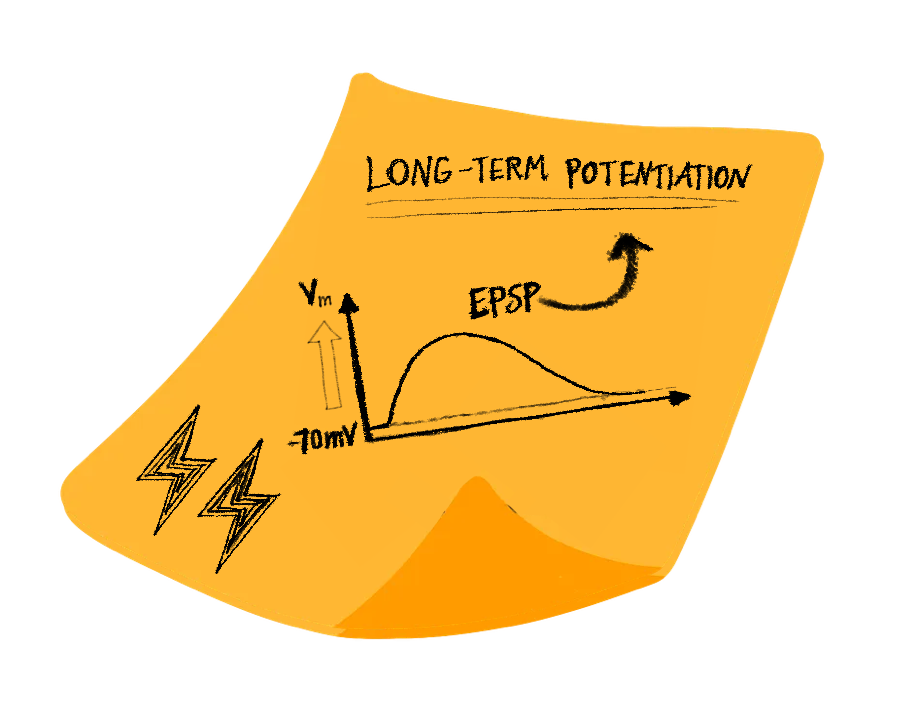Neuro Post-it 6: The Neuroscience of Learning
A new series of neuroscientific digestible insights! Written in collaboration with Cesca Centini.
Learning, in its essence, is an internal process of transformation mediated by the wonders of brain plasticity.
At times spontaneous and unwarranted. Other times deliberate and adamant. But regardless of how it happens, all types of learning is made possible by a few common neural processes that are defining elements of cognition and neuroplasticity. What’s fascinating about learning is how incredibly dynamic and powerful it is. It is the process that demonstrates how real-life experiences can physically alter the shape of our brains and its ever-evolving network of neural pathways.
Learning a new skill or acquiring new knowledge is made possible by changes in the number and strength of neural synapses, synaptic activity, and even the formation of new synapses—a process known as synaptogenesis. Depending on the intensity and amount of time spent learning, as well as the type of task or information, there are variable changes in synaptic plasticity that translates to different levels of learning.
Active learning >> Passive learning
Research, such as this one, has proven time and time again that active learning beats passive learning in efficacy. There’s no debate about it.
Active learning demands more impactful and longer-lasting changes in the brain’s neural circuits as it leads to greater levels of synaptic activity between neurons. The neurophysiological effects of this range from enlarged synaptic sizes to increased numbers of neuroreceptors on postsynaptic neurons.
But what does active learning actually look like?
Active learning entails activities such as working through math problems, translating content into your own words, and teaching someone else a topic.
As an example, take the case of reading a manual about how to perform a lab experiment vs. actually doing the experiment. Sure, reading the experiment helps you acquire information about its materials, procedures, etc.
However, until you perform the experiment step by step and learn how to run it properly, you won’t truly learn how it’s done. You could very easily read the manual and then have no clue how to appropriately carry out the steps needed to complete the experiment in the lab.
Of course, it’s always important to read the lab manual before doing the experiment to be ready and keep your brain engaged while performing it. But the lab is where the real learning takes place. Where the real synaptic connections in the brain are established.
Experimental evidence of neurochemical changes influenced by learning
Varied experiences and learning cause the brain to change and grow.
A classic experiment on learning was performed in 1972 by Mark Rosenzweig, Edward Bennet, and Marian Diamond, in which they placed rats into three different environments with varying degrees of enrichment to study the neurochemical changes and brain plasticity influenced by variable levels of learning.
What did they discover?
Lab animals living in a complex environment demonstrate significant biochemical and anatomical brain changes.
The rats were placed in three different housing conditions:
Standard: Rats placed into typical lab cages with other rats but no extra stimulation.
Impoverished: Rats placed in lab cages with no other rats or stimulation.
Enriched: Rats placed in lab cages with other rats that were full of stimulating objects like toys and tunnels, and these were changed regularly for further enrichment.
To get an idea of how significant the effects of environmental enrichment can be on cognition, note that the animals housed in the enriched condition developed:
A heavier, thicker cortex
Enhanced cholinergic activity → increase in acetylcholine neurotransmission (a significant loss of Ach activity can lead to dementia and Alzheimer’s)
More dendritic branches and spines on cortical neurons
Larger cortical synapses
More neurons in the hippocampus
Enhanced recovery from brain damage
Compared to those placed in the impoverished environment, the rats who grew up in the enriched environment generally demonstrated enhanced cortical activity, with increases particularly in their ability to learn new material and skills. This was primarily due to increased brain plasticity caused directly by the enriched environment they spent time in.
The Neurochemistry of Learning
The brain is a dynamic organ.
Learning is the foundation of its versatility.
Chemistry is the ultimate force behind it all.
Synaptic plasticity can be measured in simple hippocampal circuits. In particular, the trisynaptic circuit, in which long-term potentiation (LTP) takes place—a key mechanism for not only learning but also memory (as we learned in the previous edition of neuro post-it). more below.
Tetanus - a brief, high-frequency burst of electrical stimuli
Causes presynaptic neurons to produce a high rate of action potentials
Postsynaptic neurons respond by producing large excitatory postsynaptic potentials (EPSP).
Produces long-term potentiation (LTP) - a stable and enduring increase in the effectiveness of synapses.
Associative & Non-associative Learning
Classical conditioning, first studied by the Russian psychologist Ivan Pavlov, revolves around the idea of associative learning. In associative learning, a neutral stimulus becomes associated with an unconditioned stimulus to produce a conditioned response.
In Pavlov's famous classical conditioning experiment, dogs were conditioned to associate the sound of a bell (neutral stimulus) with the presentation of food (unconditioned stimulus). Eventually, the bell alone could elicit the same salivary response (conditioned response) that the food would. This process of pairing a neutral stimulus with an unconditioned stimulus to evoke a response highlights the malleability of behaviour through learned associations.
And this malleability of behaviour through learning again ties back to neuroplasticity, explaining how behaviours are acquired and modified through repeated experiences and associations that alter the intricate networks of neural connections in our brain.
Non-associative learning, unlike associative learning, involves only one stimulus. It is the most fundamental form of learning, requiring no association or pairing of stimuli. Specifically, it augments one’s perception of a stimulus by repeated exposure to it.
Non-associative learning entails habituation: a reduction in response due to adaptation to a repeated stimulus. This has been most prominently studied in Aplysia:
A squirt of water on an aplysia siphon causes it to retract its gill.
After repeated squirts, the animal retracts its gill less due to habituation.
What is the neurological basis behind this habituation?
Short-term habituation: less NT is released by the sensory neuron, so the gill retracts less.
Long-term habituation: the axon terminals of the sensory neurons retract from the synapse with motor neurons, and eventually there is NO response, so the gill does not retract at all.
The Neurochemistry of Learning
The brain is a dynamic organ.
Learning is the foundation of its versatility.
Chemistry is the ultimate force behind it all.
Synaptic plasticity can be measured in simple hippocampal circuits. In particular, the trisynaptic circuit, in which long-term potentiation (LTP) takes place—a key mechanism for not only learning but also memory (as we learned in the previous edition of neuro post-it). more below.
Tetanus - a brief, high-frequency burst of electrical stimuli
Causes presynaptic neurons to generate action potentials at a high rate.
Postsynaptic neurons respond by producing large excitatory postsynaptic potentials (EPSP).
Produces long-term potentiation (LTP) - a stable and enduring increase in the effectiveness of synapses.
Breaking down LTP’s neurochemical role in learning:
Magnesium ions inhibit N-Methyl-D-aspartic acid (NMDA) receptors at rest, which prevents calcium ions from entering neurons.
At the same time, sodium ions enter the postsynaptic neuron upon intense stimulation of α-amino-3-hydroxy-5-methyl-4-isoxazolepropionic acid (AMPA) receptors, depolarizing the membrane and removing the magnesium ion block from NMDA receptors.
This makes it possible for calcium to enter the postsynaptic cell, which sets off intracellular signaling cascades that alter the conformation of AMPA receptors.
AMPA receptors mediate fast excitatory synaptic transmission and initiate the processes that lead to LTP in neurons.
As a result of all this, new receptors are created, ion conductance rises, and old receptors relocate to the active synapse. Altogether, these modifications enhance synaptic efficiency, facilitating the postsynaptic neuron's activation by subsequent neural impulses. To further reinforce the strength of the synapse, LTP also involves retrograde transmission, in which the postsynaptic neuron releases transmitters that increase presynaptic glutamate release.
This entire process is consistent with the Hebbian plasticity principle, which is famously summed up by the saying "neurons that fire together, wire together." According to Hebbian theory, the more LTP takes place between neurons, the greater their synaptic strength. Because of this, LTP is highest during high-intensity active learning tasks that lead to stronger wiring of synapses. Essentially, since the blockage of NMDA receptors is blocked affects LTP, it also disrupts learning. LTP enables the neuronal changes required for learning and mastering new abilities and information through these processes.
Resources and interesting bits:
Rosenzweig MR. Modification of Brain Circuits through Experience. In: Bermúdez-Rattoni F, editor. Neural Plasticity and Memory: From Genes to Brain Imaging. Boca Raton (FL): CRC Press/Taylor & Francis; 2007. Chapter 4. https://www.ncbi.nlm.nih.gov/books/NBK3915/
Dubinsky, J. M., & Hamid, A. A. (2024). The neuroscience of active learning and direct instruction. Neuroscience and biobehavioral reviews, 163, 105737. https://doi.org/10.1016/j.neubiorev.2024.105737
Kooloos JGM, Bergman EM, Scheffers MAGP, Schepens-Franke AN, Vorstenbosch MATM. The Effect of Passive and Active Education Methods Applied in Repetition Activities on the Retention of Anatomical Knowledge. Anat Sci Educ. 2020 Jul;13(4):458-466. doi: 10.1002/ase.1924. Epub 2019 Nov 6. PMID: 31610096; PMCID: PMC7383800.
Citri, A., Malenka, R. Synaptic Plasticity: Multiple Forms, Functions, and Mechanisms.Neuropsychopharmacol 33, 18–41 (2008). https://doi.org/10.1038/sj.npp.1301559
Diamond MC, Rosenzweig MR, Bennett EL, Lindner B, Lyon L. Effects of environmental enrichment and impoverishment on rat cerebral cortex. J Neurobiol. 1972;3(1):47-64. doi: 10.1002/neu.480030105. PMID: 5028293.
Martin SJ, Shires KL, Spooner PA. The relationship between tetanus intensity and the magnitude of hippocampal long-term potentiation in vivo. Neuroscience. 2013 Feb 12;231:363-72. doi: 10.1016/j.neuroscience.2012.11.056. Epub 2012 Dec 8. PMID: 23228809; PMCID: PMC3746156.
Co-written with the beautiful
.









